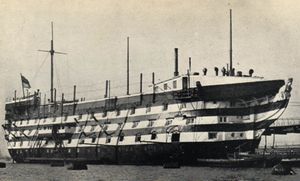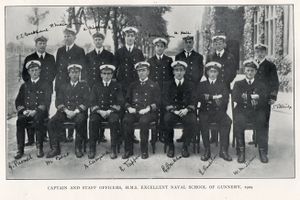Difference between revisions of "H.M.S. Excellent (Gunnery Training School)"
Simon Harley (talk | contribs) |
Simon Harley (talk | contribs) |
||
| Line 10: | Line 10: | ||
==History== | ==History== | ||
| − | In 1830 Commander George Smith, having suggested the creation of a gunnery establishment, was directed by Admiral Sir George Cockburn to find a spot in Portsmouth Harbour where a ship could be moored and fire without inconvenience. Sir Byam Martin, [[Controller of the Navy]], gave Smith permission to choose whatever old ship he needed for the purpose. The ship he chose was the ''Excellent'' | + | The foundation of a gunnery school in the [[Royal Navy]] has been attributed to Sir John Bechell and Captain William L. Bowles who had deplored the poor standard of gunnery which could be found after the War of 1812.<ref>Lloyd. ''The Origins of H.M.S. ''Excellent''. pp. 194-195.</ref> In 1830 Commander George Smith, having suggested the creation of a gunnery establishment, was directed by Admiral Sir George Cockburn to find a spot in Portsmouth Harbour where a ship could be moored and fire without inconvenience. Sir Byam Martin, [[Controller of the Navy]], gave Smith permission to choose whatever old ship he needed for the purpose. The ship he chose was the ''Excellent'' which was already moored in the site desired by Smith. He was then appointed to the ''Excellent'', in Cockburn's words, "for the purpose of establishing and carrying into effect a system of gunnery, for the instruction and information of the naval service in that branch of their duty."<ref>"Naval Gunnery" (News). ''The Times''. Friday, 20 August, 1841. Issue '''17754''', col F, pg. 3.</ref> In 1832 Captain Thomas Hastings succeeded Smith and remained in command until 1845, when he was succeeded by Captain Henry Ducie Chads.<ref>Clowes. ''History of the Royal Navy''. '''VI'''. p. 203.</ref> |
==Footnotes== | ==Footnotes== | ||
Revision as of 11:47, 14 June 2010

H.M.S. Excellent, also known as Portsmouth Gunnery School or Whale Island was the British Royal Navy's main gunnery training establishment for most of the nineteenth and twentieth centuries.
History
The foundation of a gunnery school in the Royal Navy has been attributed to Sir John Bechell and Captain William L. Bowles who had deplored the poor standard of gunnery which could be found after the War of 1812.[1] In 1830 Commander George Smith, having suggested the creation of a gunnery establishment, was directed by Admiral Sir George Cockburn to find a spot in Portsmouth Harbour where a ship could be moored and fire without inconvenience. Sir Byam Martin, Controller of the Navy, gave Smith permission to choose whatever old ship he needed for the purpose. The ship he chose was the Excellent which was already moored in the site desired by Smith. He was then appointed to the Excellent, in Cockburn's words, "for the purpose of establishing and carrying into effect a system of gunnery, for the instruction and information of the naval service in that branch of their duty."[2] In 1832 Captain Thomas Hastings succeeded Smith and remained in command until 1845, when he was succeeded by Captain Henry Ducie Chads.[3]
Footnotes
Bibliography
- Lloyd, Christopher (1955). "The Origins of H.M.S. Excellent". The Mariner's Mirror 41 (3): pp. 193-197.


